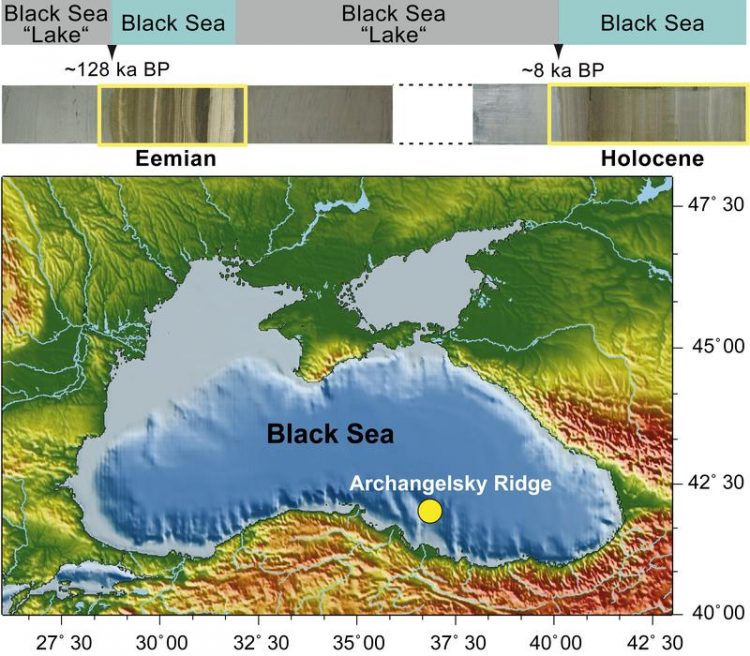Environmental history told by sludge: Global warming lets the dead zones in the Black Sea grow

Dark sediments represent „dead zones“ during warm periods like Eemian and Holocene. The warmer Eemian might serve as a bench mark for a potential future climate.
Oxygen deficiency together with the occurrence of toxic hydrogen sulphide below water depths of 100 – 150 m are the most prominent features of the Black Sea, the world´s largest brackish basin. Today, up to 90 % of the Black Sea water body is a harsh and hostile oxygen-free environment where no higher life can survive.
It is critical to understand how these dead zones will develop in response to the ongoing global warming and sea level rise. The detailed analyses of sediments from the last interglacial (Eemian) in the Black Sea, recently published in the international journal “Palaeogeography, Palaeoclimatology, Palaeoecology“ offer insights into a potential future.
Oxygen depletion in the bottom waters of the Black Sea causes a decelerated decomposition of the organic matter sinking to the seafloor. These organic-rich muds form the so-called sapropels that are quite common among both recent and Eemian deposits.
By means of detailed analyses of redox-sensitive chemical elements in these sapropels, the team succeeded in reconstructing a differentiated picture of the deep-water conditions during the Holocene and Eemian periods in the Black Sea.
As environmental witnesses (so-called proxies) the geoscientists used, for example, the trace elements molybdenum and rhenium, which react differently and specifically on oxygen deficiency and the presence of sulphide. In total, the analysis of more than 10 of such proxies enabled the reconstruction of a complex picture.
IOW geologist Antje Wegwerth summarizes the results: ”During the Eemian period the deep water of the Black Sea showed a significantly higher concentration of sulphide and, thus, was more toxic than today. The hostile conditions expanded over thousands of years and finally reached the so called photic zone, the highly productive surface water layer exposed to light.”
In such a resolution and quality, no Eemian sediments have been investigated so far, because these deep lying deposits are normally accessible only by expensive deep-sea drillings. However, during a cruise on R/V METEOR sediments from both Holocene and Eemian periods could be retrieved by conventional gravity coring from a prominent bathymetric ridge structure. Thus, the direct comparison of both interglacials became possible.
Postglacial warming during the Eemian and the Holocene caused significant changes in the Black Sea. The large polar ice sheets disappeared, the global sea level rose, and once flooding the shallow Bosporus sill, the salty and dense water masses of the Mediterranean Sea intruded the formerly Black Sea “Lake”. This led to a strong stratification with saline deep waters below the brackish surface waters.
At the same time, elevated sea surface temperatures resulted in an increased productivity and flux of organic matter, ultimately exhausting oxygen in the basin during its decomposition. The interaction of these processes finally lead to the generation of enormous “dead zones” in the Black Sea.
References:
Wegwerth, A., Eckert, S., Dellwig, O., Schnetger, B., Severmann, S., Weyer, S., Brüske, A., Kaiser, J., Köster, J., Arz, H.W., Brumsack, H.-J. Redox evolution during Eemian and Holocene sapropel formation in the Black Sea. Palaeogeography, Palaeoclimatology, Palaeoecology (2018) 489, 249-260
https://doi.org/10.1016/j.palaeo.2017.10.014
Scientific expert:
Dr. Antje Wegwerth, +49 381 5197 3481, Antje.Wegwerth@io-warnemuende.de
Press and public relation:
Dr. Barbara Hentzsch | +49 381 5197-102 | Barbara.Hentzsch@io-warnemuende.de
IOW is a member of the Leibniz Association with currently 91 research institutes and scientific infrastructure facilities. The focus of the Leibniz Institutes ranges from natural, engineering and environmental sciences to economic, social and space sciences as well as to the humanities. The institutes are jointly financed at the state and national levels. The Leibniz Institutes employ a total of 18.100 people, of whom 9.200 are scientists. The total budget of the institutes is 1.6 billion Euros. (http://www.leibniz-association.eu)
Media Contact
All latest news from the category: Earth Sciences
Earth Sciences (also referred to as Geosciences), which deals with basic issues surrounding our planet, plays a vital role in the area of energy and raw materials supply.
Earth Sciences comprises subjects such as geology, geography, geological informatics, paleontology, mineralogy, petrography, crystallography, geophysics, geodesy, glaciology, cartography, photogrammetry, meteorology and seismology, early-warning systems, earthquake research and polar research.
Newest articles

First-of-its-kind study uses remote sensing to monitor plastic debris in rivers and lakes
Remote sensing creates a cost-effective solution to monitoring plastic pollution. A first-of-its-kind study from researchers at the University of Minnesota Twin Cities shows how remote sensing can help monitor and…

Laser-based artificial neuron mimics nerve cell functions at lightning speed
With a processing speed a billion times faster than nature, chip-based laser neuron could help advance AI tasks such as pattern recognition and sequence prediction. Researchers have developed a laser-based…

Optimising the processing of plastic waste
Just one look in the yellow bin reveals a colourful jumble of different types of plastic. However, the purer and more uniform plastic waste is, the easier it is to…



